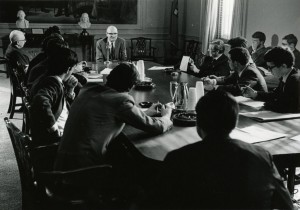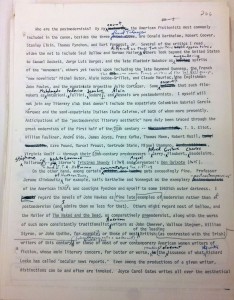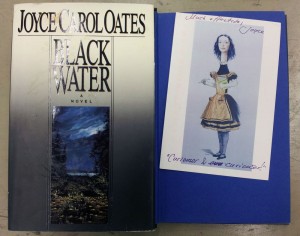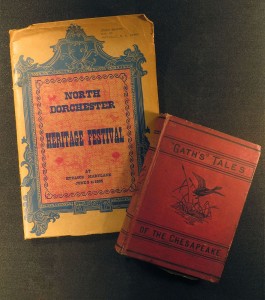What do you call 30-odd boxes of books and 25 boxes of manuscripts, letters, newspaper reviews, notebooks, and assorted papers?
Well, if those boxes contain essential primary sources for the study of contemporary American literature, you call it the John Barth Collection.
Today, we in the Sheridan Libraries are so pleased to announce our acquisition of this collection, which documents the creative output and career of John Barth, the fiction writer, essayist, and teacher in Hopkins’ own Writing Seminars.
 Barth’s work, both prolific and experimental, spans some big territory. On one hand, you can’t really understand the emergence of international postmodernism without reference to his story “Lost in the Funhouse” or the novel LETTERS. On the other hand, if you love the Eastern Shore, its people, its land, and especially its waters, you can’t do better than The Floating Opera or The Tidewater Tales. Multiply that a few times—Barth has published seventeen novels and collections of short fiction and three collections of essays—and divide it by several major honors (like the National Book Award), and you’ll start to see the significance of the collection.
Barth’s work, both prolific and experimental, spans some big territory. On one hand, you can’t really understand the emergence of international postmodernism without reference to his story “Lost in the Funhouse” or the novel LETTERS. On the other hand, if you love the Eastern Shore, its people, its land, and especially its waters, you can’t do better than The Floating Opera or The Tidewater Tales. Multiply that a few times—Barth has published seventeen novels and collections of short fiction and three collections of essays—and divide it by several major honors (like the National Book Award), and you’ll start to see the significance of the collection.
John Barth, born in Cambridge, Maryland, came to Hopkins in 1951 for his bachelor’s and master’s degrees. He returned to his alma mater in 1973, teaching in the Writing Seminars until his retirement in 1995, and received an honorary Doctorate of Humane Letters from Hopkins in 2011.
 “I’m pleased to have these materials at Johns Hopkins, because it was at Hopkins—and largely thanks to Hopkins and my fine undergraduate- and graduate-school professors—that I managed to become a writer,” says Barth.
“I’m pleased to have these materials at Johns Hopkins, because it was at Hopkins—and largely thanks to Hopkins and my fine undergraduate- and graduate-school professors—that I managed to become a writer,” says Barth.
In turn, he helped to educate a generation of writers—one of those professors we call “beloved” not because he was easy but because he was both challenging and magnanimous. “Jack was a memorable teacher and writing mentor: pithy, exacting, generous, funny, and one to whom students feel a lifetime of loyalty and affection,” recalls Jean McGarry, co-chair of the Writing Seminars. Other faculty members who are also former Barth students agree; Glenn Blake notes, “I have been fortunate to study with many writing coaches, but Jack is truly The Master—the teacher, the erudite scholar, the precise editor. I am convinced that he spent more time editing our flawed fictions than we spent writing them. Jack painstakingly line edited our scenes, our chapters, our stories, with a red ink pen, and then covered the backs of our sheets with comments in black ink.”

The Barth collection contains the complete extant notes and manuscripts for Barth’s published writings and many of his lectures, correspondence with major literary figures, all of the editions published in English of Barth’s work and many translations, journals and anthologies that include Barth’s writing, and works of criticism. In addition, the collection includes most of the 1200-volume library of Barth and his wife Shelly: books belonging to Barth from his student days, with his annotations; books inscribed by students, colleagues, and important writers of the past several decades; and books that  were instrumental to Barth in his own writing. There are also photographs, recordings, juvenilia, and home-made posters and slides that Barth used to illustrate talks and readings. All told, the collection will illuminate the techniques of a writer McGarry calls a “ground-breaking stylist… who influenced many younger writers such as Julian Barnes, David Foster Wallace, and Salman Rushdie, to name just a few.” And it will offer researchers unrivaled
were instrumental to Barth in his own writing. There are also photographs, recordings, juvenilia, and home-made posters and slides that Barth used to illustrate talks and readings. All told, the collection will illuminate the techniques of a writer McGarry calls a “ground-breaking stylist… who influenced many younger writers such as Julian Barnes, David Foster Wallace, and Salman Rushdie, to name just a few.” And it will offer researchers unrivaled opportunities to study more broadly the literature of the late twentieth and early twenty-first centuries—”a time of great change in terms of literary culture, reading practices, and publishing opportunities,” observes Winston Tabb, Sheridan Dean of University Libraries and Museums.
opportunities to study more broadly the literature of the late twentieth and early twenty-first centuries—”a time of great change in terms of literary culture, reading practices, and publishing opportunities,” observes Winston Tabb, Sheridan Dean of University Libraries and Museums.
The John Barth Collection will be the subject of a major exhibition in the fall of 2015, when most of it will also be opened up to researchers. Selections from the collection can be viewed here.

Photos from the October 18 event can be seen here:
https://www.flickr.com/photos/brodylc/albums/72157659990249519
Hi! We were at the event and your photographer took a photo of us – any chance the photos will be posted somewhere or we could get in touch with your photographer? Thanks!
Thanks for your interest! Details are still pending for the 10/18/15 exhibition opening, so stay tuned for an announcement in the near future.
I heard a special event was planned related to the John Barth Collection on 10/18/2015. Can you tell me more about that?